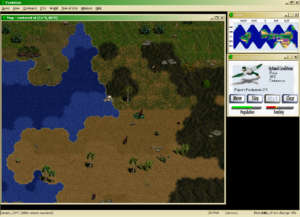Evolution
 Sometime around the year 2000, when the dot-com bubble was deflating — a period that left me in a painful state of burnout, as the reduced demand for programmers paradoxically increased the demands on programmers — I spent a brief stint working under contract to Unplugged Games, Greg Costikyan’s premature venture to put games on cell phones. I honestly didn’t know who Costikyan was at the time, or who he would later become. If I had, I might have approached the work there with a more positive attitude. As it is, I did try to learn a bit about the man’s past work by picking up a copy of Evolution: The Game of Intelligent Life, but I didn’t spend long playing it. It seemed dauntingly complex, and unintuitive to interact with. My first sessions were spent thrashing about wondering what I could do and watching the computer-controlled opponents encroach on what I thought of as my territory.
Sometime around the year 2000, when the dot-com bubble was deflating — a period that left me in a painful state of burnout, as the reduced demand for programmers paradoxically increased the demands on programmers — I spent a brief stint working under contract to Unplugged Games, Greg Costikyan’s premature venture to put games on cell phones. I honestly didn’t know who Costikyan was at the time, or who he would later become. If I had, I might have approached the work there with a more positive attitude. As it is, I did try to learn a bit about the man’s past work by picking up a copy of Evolution: The Game of Intelligent Life, but I didn’t spend long playing it. It seemed dauntingly complex, and unintuitive to interact with. My first sessions were spent thrashing about wondering what I could do and watching the computer-controlled opponents encroach on what I thought of as my territory.
Going back to it now, I think I’m doing a little better, having read enough of the voluminous documentation to understand the basic underlying mechanics. But I’m still definitely in the thrashing-about phase, capable of evolving new species but incapable of keeping them alive. The manual says that a single full game takes about six hours (and that’s a fixed length — the game is realtime and progresses through distinct phases regardless of player actions), but it’s clear that I’m going to need multiple practice sessions before I can go for a win.
The game content concerns the evolution of tetrapods up to the development of intelligent life. (So, no trilobites or burgess shale creatures here, fascinating episodes in evolutionary history though they are.) Note that “Intelligent life” here doesn’t necessarily mean humans. There are several possible contenders, based on what-ifs: Psittacisapiens (evolved from parrots, which are already well-adapted to developing spoken language), Elephasapiens (from elephants, which have large brains and a dextrous frontal appendage for manipulating tools 1Not to mention the fact that, like parrots, they’re one of the few animals known to vocally imitate heard sounds — although this hadn’t yet been observed at the time this game was made. ), and a few others. These, and their immediate ancestors, are the only made-up creatures in the game, and also the most significant creatures, because the first player to develop intelligence wins. Or, well, that’s not quite right: according to the manual, developing intelligent life ends the game, at which point the clade with the most points wins. Points are awarded for achieving various milestones (first dinosaur, first mammal, etc), as well as for total biomass and diversity, but intelligence is the game’s golden snitch, giving you a 50% bonus on everything else.
But that’s the ending, which I haven’t got anywhere near yet. At the beginning, all you have is a single early amphibian species. This strikes me as just about the worst place for a beginner. I have some intuitive notions about the differences between wolves and squirrels and giraffes and so forth. I even have some expectations about the mastodon, the eohippus, the tyrannosaur, etc. But when I’m given the choice of what to evolve next, I have to choose between things like eogyrinus and diplocaulus, and I have no idea what their relative merits are. But I suppose this is what makes the game educational. Still, it probably means I should switch to playing the Cenozoic scenario to get used to the game mechanics and strategy on more familiar grounds before trying to tackle a full game.
To me, the game it most clearly evokes is Civilization: it’s a game played on a world map at a large time scale (although here the time scale is large enough for plate tectonics to significantly alter the map over the course of a game), in which you expand your population and pursue a branching tree of developments, competing with a number of opponents for advancement and dominance. In fact, it reminds me a little of the Civ II “Age of Reptiles” mod, in which all your units were dinosaurs, and you researched technologies like “serrated teeth” and “bony plates” in order to build new types of dinosaur. But that was ultimately played within the framework of Civ, which meant that it was all based on your dinosaurs doing unlikely things like living in cities and tilling the soil. Really, in some ways, this game plays a lot more like a competitive version of The Gungan Frontier. Creatures roam about freely unless told not to, reproduce spontaneously if they’re healthy and well-fed, even potentially prey on their teammates.
More about the game mechanics next time.
| ↑1 | Not to mention the fact that, like parrots, they’re one of the few animals known to vocally imitate heard sounds — although this hadn’t yet been observed at the time this game was made. |
|---|
 Comments(0)
Comments(0)